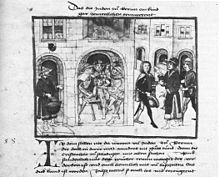Rudolf of Bern
When Rudolf von Bern (* around 1290 in Bern , Switzerland ; † April 17, 1294 ibid) became known a child, for whose murder the Jews of Bern had been held responsible according to the model of the ritual murder legend and who was later venerated as a martyr at times .
Because of the rumor that Rudolf was murdered by Jews, a pogrom broke out in Bern in which the Jews were attacked and looted.
Although the authorities did not believe in the guilt of the Jews, they saw popular anger as an opportunity to pay off debts to Jewish donors. The authorities made a decision to expel the Jews from the city forever.
The persecuted Jews complained to the Roman-German King Adolf von Nassau , but the committee appointed by him made an arbitration award in favor of the imperial city of Bern, according to which the Bernese Jews lost all their assets and all Bernese pledges and mortgage notes, as well as a high one to the mayor and the city Had to pay a fine. The files show that neither the king nor the court believed in ritual murder . The mayor in his receipt of penance from 1294 and Adolf's successor Albrecht I von Habsburg in his confirmation of the verdict explicitly only spoke of an "alleged" murder.
Miracles are said to have occurred at Rudolf's grave in the Leutkirche in Bern. When the Bern Minster was built in place of the Leutkirche , the bones were transferred to its cross altar; however, the cult of the boy was never officially confirmed. During the iconoclasm in 1528, the bones were removed from the cathedral and buried outside the church.
The Kindlifresserbrunnen , built in Bern in the middle of the 16th century, is supposed to commemorate the alleged ritual murder according to a theory by Karl Howald that is considered to be outdated .
Rudolf is iconographically represented with the saints attributes palm , cross and knife; sometimes he lies badly wounded on the ground.
- See also: Bern Jewish Community and Judaism in Switzerland
literature
- Ekkart Sauser : Rudolf von Bern. In: Biographisch-Bibliographisches Kirchenlexikon (BBKL). Volume 22, Bautz, Nordhausen 2003, ISBN 3-88309-133-2 , Sp. 1170-1171.
Web links
- Emil Dreifuss: Jews in Bern; Bern 1983
- Kindlifresserbrunnen ( Memento from January 10, 2012 in the Internet Archive )
Individual evidence
- ↑ State Archives of the Canton of Bern, A II 96, Ratsmanual 216, p. 151 (February 10, 1528): “The kindli that would lie in the holy Crütz alltar should be buried in the ertrich and a zedell ingested that it the kindli should be, so Vorzyten die Jews hand etc. "
| personal data | |
|---|---|
| SURNAME | Rudolf of Bern |
| BRIEF DESCRIPTION | Swiss child for whose death Jews were held responsible as alleged ritual murderers |
| DATE OF BIRTH | around 1290 |
| PLACE OF BIRTH | Bern |
| DATE OF DEATH | April 17, 1294 |
| Place of death | Bern |
